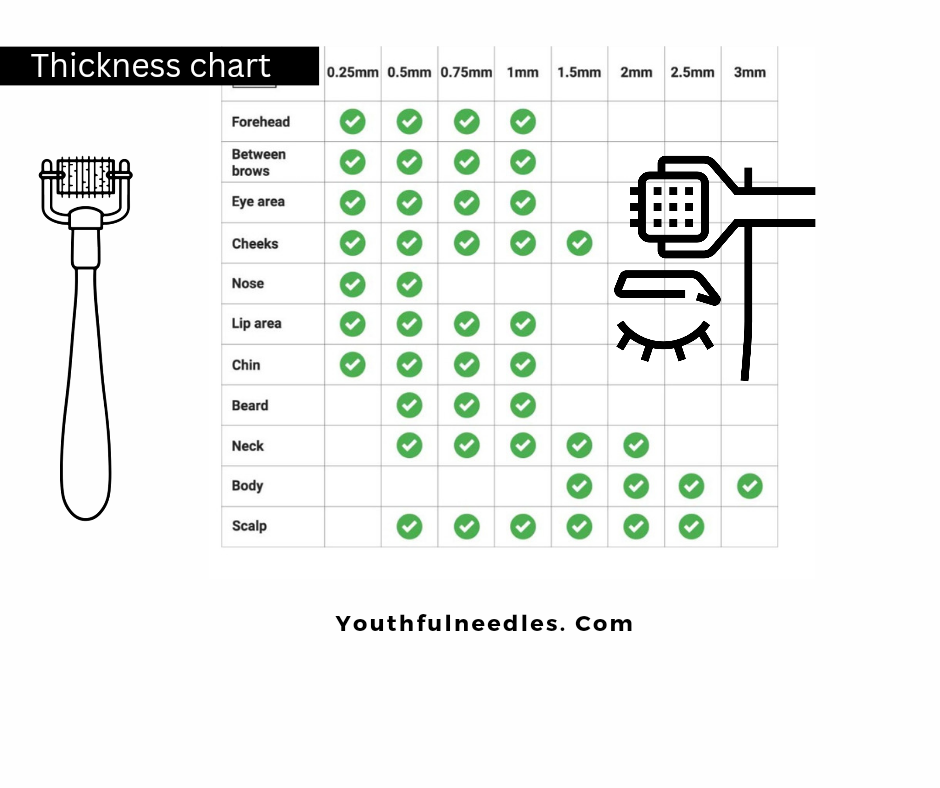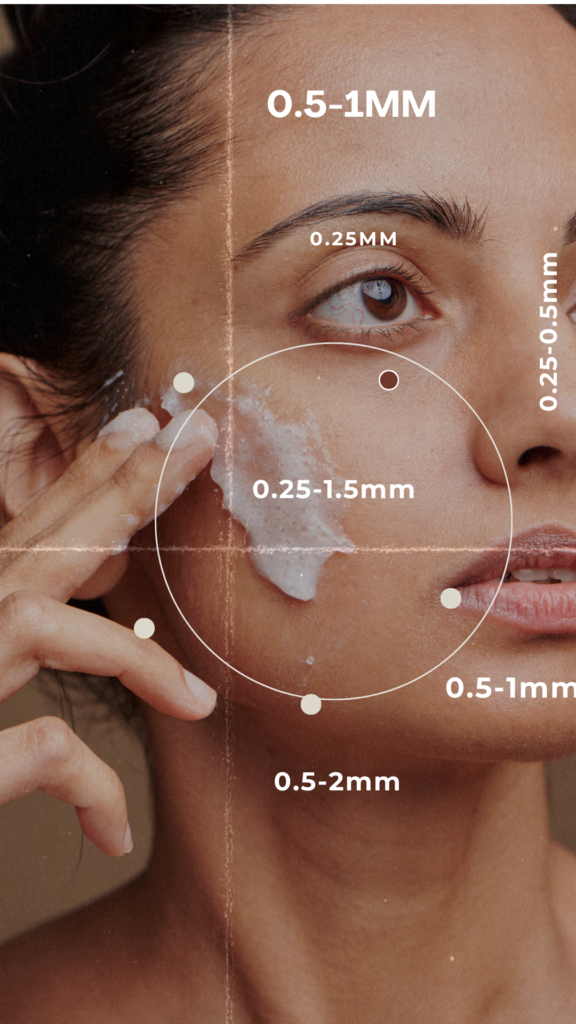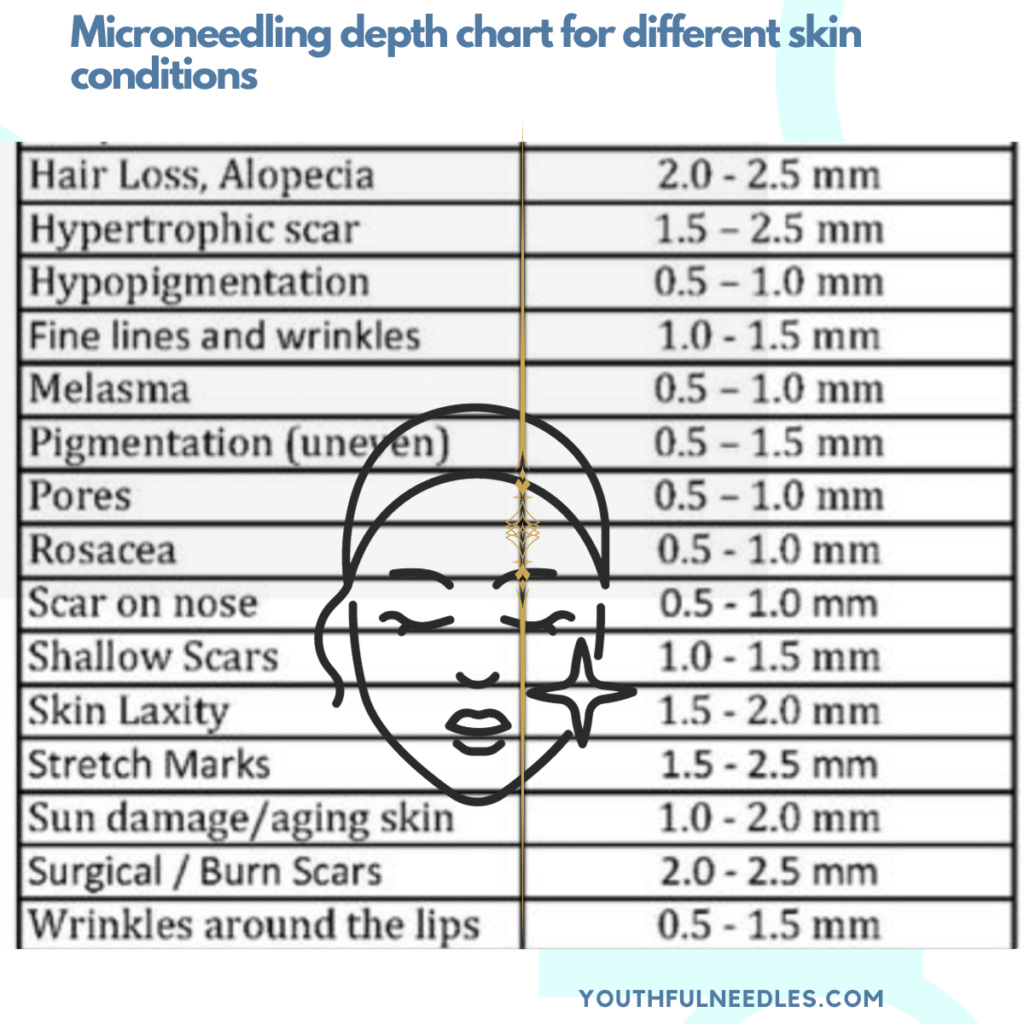Microneedling Depth Chart: Needle depth for face, body and targeted areas.
Updated: 30 November 2023
268

Are you considering microneedling but unsure about the right needle depth for different body parts? Look no further! In this comprehensive microneedling depth chart article, we will provide you with all the information you need to know about microneedling techniques for different areas of your body.
Microneedling depth chart: Complete guide for professionals
Microneedling is a minimally invasive procedure that uses small needles to create controlled punctures on the skin’s surface. These micro-injuries stimulate collagen production and enhance the absorption of skincare products. However, achieving optimal results depends on using the correct needle depth for specific body parts.
What is the purpose of microneedle depth chart?
Microneedling depth chart will guide you through the recommended needle depths for areas like the face, neck, chest, hands, and more. We will discuss the considerations for each body part, such as the thickness of the skin and sensitivity levels, to help you make informed decisions.
Whether you are a professional aesthetician or exploring at-home microneedling, this article will equip you with the knowledge to maximize the benefits of microneedling and achieve healthier, rejuvenated skin by evaluationof microneedling depth chart. Let’s dive into this comprehensive needle depth chart and discover the right microneedling techniques for different body parts.
Understanding needle depth microneedling face chart
Before we dive into the recommended needle depths for different body parts, it’s essential to understand how needle depth affects the results of microneedling. The depth of the needles used during microneedling can vary from 0.25mm to 3.0mm. The depth of the needles determines how deep the micro-injuries penetrate the skin. The deeper the needle depth, the more significant the impact on collagen production and skin rejuvenation. However, deeper needle depths can also increase the risk of complications, such as scarring, infection, and hyperpigmentation.

Microneedling Depth Chart: Needle depth for face, body and targeted areas.
Using the correct needle depth is crucial to achieving optimal results and minimizing the risk of complications. Using a needle depth that is too shallow may not penetrate the skin enough to stimulate collagen production, while using a needle depth that is too deep can cause scarring and other complications. The correct needle depth depends on various factors such as the thickness of the skin, the sensitivity of the area, and the desired results.
Factors to consider when selecting needle depth for different body parts
When selecting the appropriate needle depth for different areas of the body, there are several factors to consider. The thickness of the skin is a crucial factor in determining the needle depth. The skin on the face and neck is thinner than the skin on the body, so a shallower needle depth is recommended for these areas. The sensitivity of the area is another factor to consider. The skin around the eyes is more sensitive than other areas of the face, so a shallower needle depth is recommended. Lastly, the desired results should be considered. Deeper needle depths are recommended for treating scars and stretch marks.
What is the dermapen Microneedling depth chart for the face?
When microneedling the face, the needle depth should be adjusted depending on the area being treated. For the forehead, cheeks, and chin, a needle depth of 0.5mm to 1.0mm is recommended. For the areas around the eyes, a shallower needle depth of 0.25mm to 0.5mm is recommended. The nose and lip areas can be micro needled with a depth of 0.75mm to 1.0mm.

Depth microneedling face chart
Is needle depth chart same for every skin type?
It’s important to note that the needle depth should be adjusted for different skin types. People with thicker skin can use a slightly deeper needle depth, while people with sensitive skin should use a shallower needle depth.
What is the microneedling depth guide neck and décolletage?
The skin on the neck and décolletage is thinner than the skin on the face, so a shallower needle depth is recommended. A needle depth of 0.5mm to 1.0mm is recommended for these areas. It’s important to be cautious when microneedling the neck as it is a sensitive area. Start with a shallower needle depth and gradually increase the depth if necessary.
What is microneedling depth for hands,body – arms, legs, and stomach?
The skin on the body is thicker than the skin on the face, so a deeper needle depth is recommended for microneedling these areas. A needle depth of 1.0mm to 2.0mm is recommended for the arms, legs, and stomach. It’s essential to be cautious when microneedling the body as deeper needle depths can increase the risk of complications. Start with a shallower needle depth and gradually increase the depth if necessary.
Dermapen Microneedling depth guide for acne scars, stretch marks, and cellulite
Deeper needle depths are recommended for treating scars, stretch marks, and cellulite. A needle depth of 1.5mm to 2.5mm is recommended for these target areas. It’s important to note that microneedling these areas can be more painful, so a topical anaesthetic may be necessary.
It’s also important to take extra precautions when microneedling scars, stretch marks, and cellulite. These areas are more prone to complications, such as infection and hyperpigmentation. It’s crucial to follow proper skincare and aftercare instructions to minimize the risk of complications.
What is it necessary to adjust micro needle depth for different skin conditions?
Adjusting the needle depth for different skin types and different skin conditions is essential to achieve optimal results and minimize the risk of complications. People with thicker skin can use a slightly deeper needle depth, while people with sensitive skin should use a shallower needle depth. People with darker skin should also use a shallower needle depth to minimize the risk of hyperpigmentation. Similarly, people having deep acne scars will be treated at different speed and depth and people with slight acne will be treated differently.
Here is the chart to depict needle depth for different skin conditions.

Microneedling Depth chart for different skin conditions
Final tips for safe and effective microneedling techniques
Microneedling is an effective skincare treatment that can improve the appearance of fine lines, wrinkles, scars, and stretch marks. However, achieving optimal results depends on using the correct needle depth for specific body parts and skin types. Use our comprehensive needle depth chart as a guide to help you make informed decisions and achieve healthier, rejuvenated skin.
When microneedling, it’s crucial to follow proper skincare and aftercare instructions to minimize the risk of complications. Always use a clean and sterile microneedling device, and do not share your device with others. Additionally, avoid microneedling on active acne or open wounds.
Finally, if you’re unsure about the appropriate needle depth for your skin type or concerned about the risk of complications, consult with a skincare professional before attempting microneedling at home.
With the right needle depth and proper technique, microneedling can be a safe and effective way to improve the appearance of your skin and achieve a more youthful, radiant complexion.
| Disclaimer |
|---|
Before trying any procedure at home follow the guidelines. The charts provided are for informational purpose only and it is highly recommended to consult a physician or a dermatologist to carryout the procedure. How deep does microneedling go?In professional microneedling, the depth of needle penetration can vary from 0.5 mm to as deep as 3.0 mm, based on the specific skin condition being treated and the area of the body. Here’s how the depth typically varies. Lighter Treatments (0.5 – 1.0 mm) This depth is generally used for treating superficial skin issues like fine lines or minor scarring Intermediate Treatments (1.0 – 2.0 mm) This range is better suited for addressing deeper skin problems, including more pronounced wrinkles, scars, or stretch marks. Intensive Treatments (Up to 3.0 mm) The deepest level of treatment, usually for more severe skin conditions like deep scarring or significant texture irregularities.Such deep treatments require professional expertise and often have more extensive recovery time and a greater possibility of side effects, underlining the need for them to be conducted by experienced skincare professionals. |
Please Write Your Comments